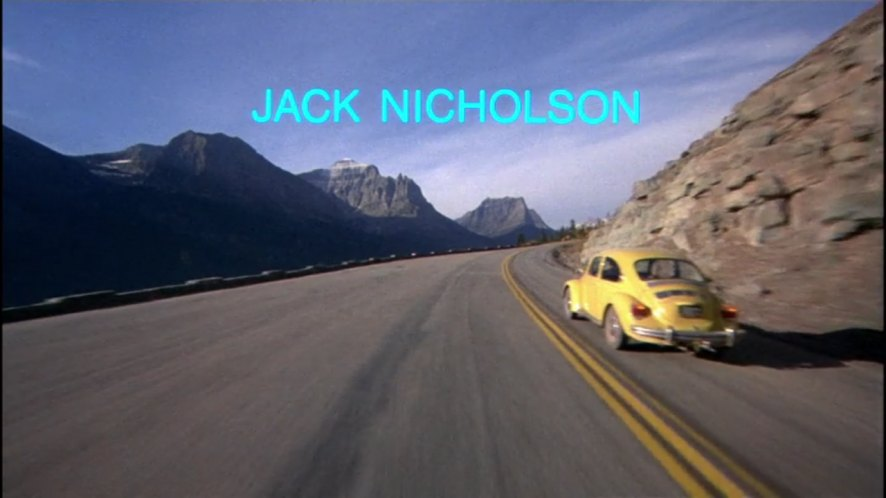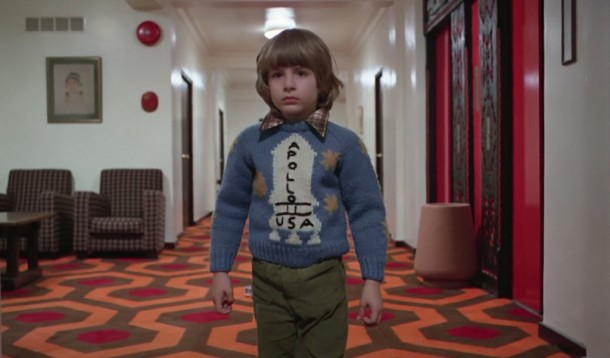There has been much discussion about Jack’s yellow VW Beetle in The Shining. In the book by Stephen King, the car was red and many have speculated that Kubrick changed it as a message to the author. Later on in the film we do see a red VW Beetle that’s been crushed by a semi trailer. It’s as if Kubrick’s saying to King – I smashed your little story and made it my own. That’s a perfectly valid analysis but I’m here to offer a much juicier interpretation that involves Julian Koenig, Sarah Koenig’s dad. Sarah Koenig was the presenter of the wildly successful podcast, Serial.
Fair warning, this is gonna get a little esoteric. I’m going to be drawing a long bow – about visual semantics and Kubrick’s love of hiding cryptic messages in his films. And while a film like The Shining seems to defy systematic analysis, Christiane Kubrick has said that it is “about horror on many levels.”
Firstly, we must acknowledge Kubrick’s fascination with cryptic codes, clues and symbols. Starting his career as a photographer, he quickly learned the power of images. At age 16, his photo of a newspaper salesman on the day of Roosevelt’s death was published in Look magazine. He soon became one of their staff photographers.
Kubrick was purportedly very interested in advertising and the shorthand way that advertisements could convey meaning in just a few words and pictures. He is also claimed to have believed that The Codebreakers The Story of Secret Writing by David Kahn is one of the most important books ever written.
With that in mind – the VW Beetle. This iconic car is steeped in lore. From sordid Nazi roots involving claims of slavery and murder to world domination in mere decades. Perhaps the most well loved car of all time. One of the most important markets for the VW was the US. North Americans traditionally loved big cars and selling the diminutive Beetle in 1959 wasn’t going to be easy. To do it, three men came up with what AdAge called “The Ad Campaign of the Twentieth Century”. They practically rewrote advertising. Of course, I’m referring to the famous Think Small and Lemon ad campaign, written by Julian Koenig (Sarah’s dad) and art directed by Helmut Krone.

The Lemon ad labels the car as bad but then goes on to explain how VW’s rigorous quality checking means you always get a good one. The quiet confidence of the ads made a car with seemingly irreconcilable Nazi roots palatable to a new counter-culture generation. They might have been able to overlook it’s evil beginnings but Kubrick didn’t forget that this little lemon was really a Nazi. Even though the ad is in black and white and the car is obviously a dark colour, the lemon/yellow reference got stored away somewhere in his huge vault of a brain as a symbol of “terror in a cutesy disguise” and, I suggest, informed the colour of psychopathic killer Jack Torrance’s Beetle in The Shining.

But what’s that got to do with anything, I hear you ask? OK, here come the astronauts. Now this might be a stretch for some but you’ve really gotta believe that Kubrick was involved or at the very least knew some inside information about the Apollo moon missions. Either that, or he knows that’s what a lot of folks think, so he’s having a laugh at our expense. No matter how vociferously some people want to claim that The Shining does not refer to the moon landings, Danny is wearing that damn Apollo 11 sweater on his fateful trip to room 237, arguably the most pivotal and infamous point in the movie. Kubrick’s involvement with NASA is well documented. Two of his other movies, 2001 and Barry Lyndon, were made with the help of the space agency (cameras, lenses, funding etc.) The opening scenes of Jack in the Lemon/Yellow (Nazi designed) Beetle just happen to be shot on “Going to the Sun road”. Coincidentally (or not), Apollo is god of the sun. NASA and its Apollo space program grew out of the ashes of the Nazi rocket program. The U.S.’s Joint Intelligence Objectives Agency (JIOA) and special agents of the U.S. Army’s Counterintelligence Corps (CIC) brought Wernher Von Braun and other Nazi scientists into America, under Operation Paperclip, supposedly to help hasten the ending of the war against Japan. Von Braun, whose avuncular portrayal in government-sponsored media belied his Nazi past, developed the Saturn 5 rocket engines that took U.S. astronauts to the moon aboard Apollo 11. This was a huge psychological blow against the Russians and gave America the ascendency in The Cold War.

Before the Apollo program, however, there was another NASA program called Gemini. Fans of The Shining may see some thematic synergy with the Gemini and Grady twins. The Gemini program did not end well. Some people have called it murder (or REDRUM, if you prefer). Astronauts Gus Grissom, Edward H. White and Roger Chaffey were burned alive when a fire broke out in their test module (say like, if someone burns toast). Grissom’s family have long held that Gemini Astronauts were “taken out” by elements within the U.S. government (stacked neatly in the West Wing?) Grissom, in particular, had been a difficult character for the U.S. space agency to deal with. He’d previously been blamed for sinking the Liberty Bell 7 space capsule when he supposedly opened the hatch incorrectly – an incident he always denied and that was made famous by author Tom Wolfe when he claimed Grissom had “Screwed the Pooch” in his book The Right Stuff. Again, Shining fans may infer a reference to screwing the pooch in The Shining’s dog/bear fellatio scene. But here’s where it gets interesting – in the days prior to his death, Grissom, who was touted as being the first man on the moon, had been vocal that Apollo would never make it to the moon, saying they were ten years away from anything of the sort. He claimed the rockets they had were no good. He said Apollo 1 was a lemon. In fact, he reportedly hung a real lemon on the Apollo training module.

I contend that Kubrick cleverly used a lemon yellow VW in The Shining to encode a message about the Nazi roots of the Apollo space program. It’s about how we forget – how we conveniently forgot that both the VW Beetle and the Apollo space program were born out of the murderous horrors of the barbaric Nazi regime. Kubrick reminds us of this connection by pointing out that both vehicles were famously labelled as lemons and by changing the colour of his murderous protagonist’s Beetle to yellow in homage to the famous ad campaign. Kubrick wanted us to remember that horror exists on many levels despite attempts to overwrite it with slick advertising and despite efforts to repress it by intelligence agencies wanting to advance national interests. Or maybe the yellow Beetle is just a shout out to Stephen King.
